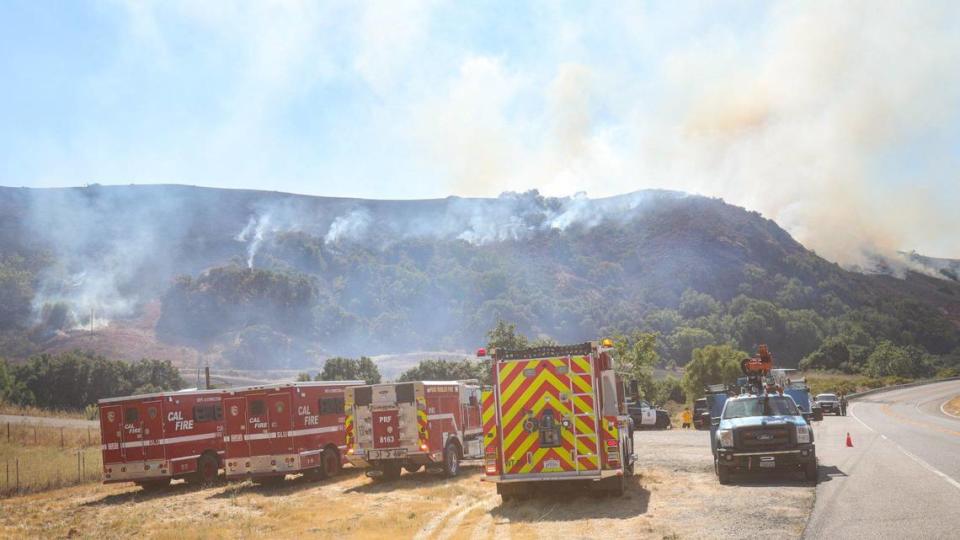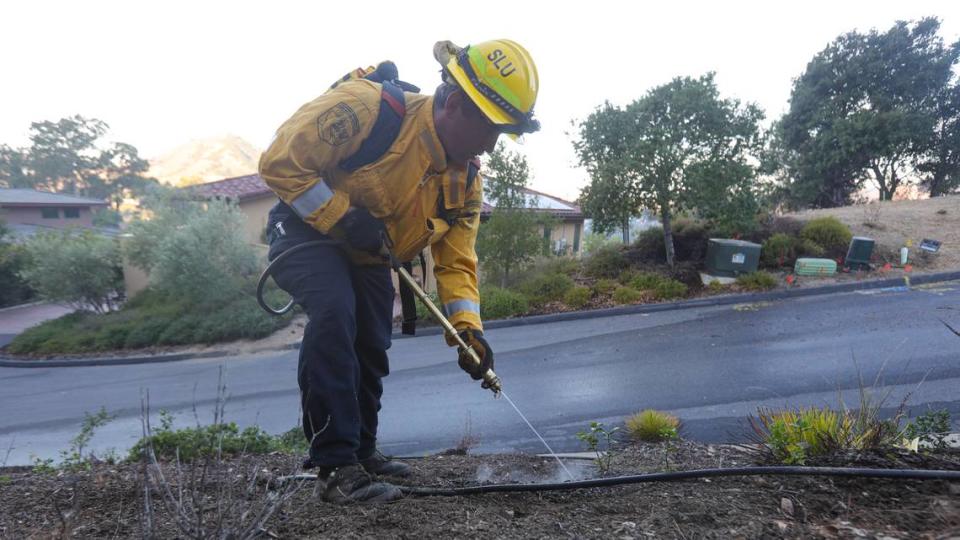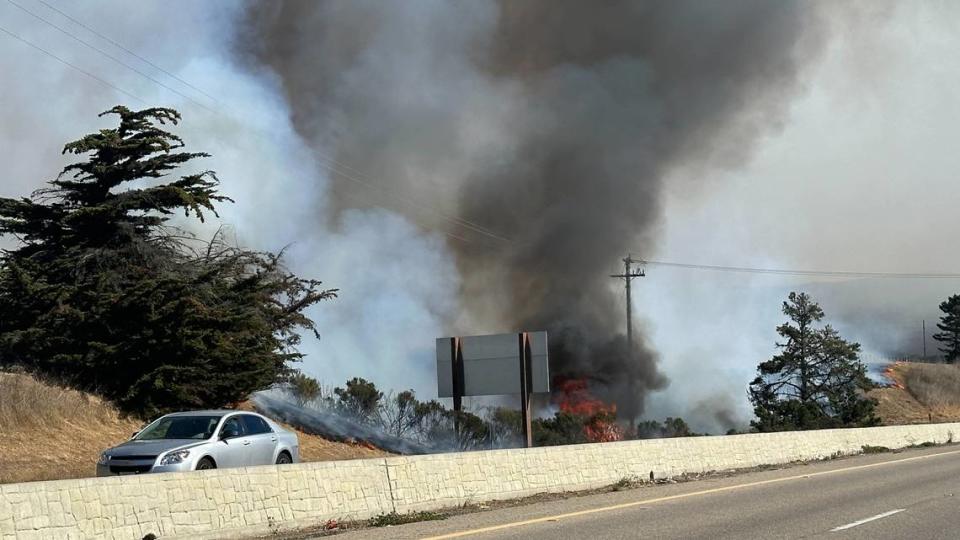What’s causing all these fires? SLO County off to an early start to the season
Late springtime heat is sucking the water out of San Luis Obispo County’s grasslands, leaving ample fuel for wildfires and setting the stage for a hot, dry and potentially risky summer.
Fire engines race down the highway, sirens blaring, to battle the blazes, while the police scanner buzzes as crews coordinate their response to fires burning across the county.
San Luis Obispo County is entering a higher fire danger period, and Cal Fire started battling small vegetation fires more frequently in late May, according to Cal Fire spokesperson Toni Davis.
“The hillsides used to be nice and green, and now they’re turning brown and yellow,” Davis said. “That’s usually a good indicator that we’re getting pretty close to our our higher fire danger time of year.”
Thanks to the rainy winter, however, the county likely won’t experience large wildfires until late summer or early fall, according to a June report published by the National Interagency Fire Center.
What’s causing all these fires?
On May 27, smoke billowed across the county as Cal Fire hurried to extinguish at least six small fires, Davis said.
“They were all kept under an acre, but it happened throughout the day from 10 until at least 4,” she said.
Cal Fire was still investigating the cause of those fires on Wednesday, Davis said, but most of them burned beside roads — which means vehicles are the likely culprit.
Chains dragging behind trucks can send sparks into nearby vegetation and start fire, Davis said. Embers spewing from a malfunctioning car could also kindle a roadside blaze, she said.
“There may be some small grass, that tiny little grass crop that carries an ember from your car, and then, boom — we have a wildland fire,” Davis said.

Davis advised drivers to keep their cars in good working condition and avoid parking in vegetated areas on the side of the road. When possible, pull over at paved turnouts instead, she said.
Meanwhile, mowing a field on a hot, windy day with the wrong equipment can also start a fire, Davis said.
People should use tractors instead of lawn mowers to cut vegetation in dry fields, Davis said. If a lawn mower’s blade strikes a rock on a hot day, it will likely send sparks into the grass.
“95% of the fires that we deal with are human error,” Davis said. “Remember: One less spark, one less wild fire.”
SLO County to see more wildfires in late summer
San Luis Obispo County can expect a slow start to fire season this summer, Cal Fire forester Dave Erickson told The Tribune.
In June, wild grasses are still drying out and dying in San Luis Obispo County. But large winter storms saturated the county’s shrubs and trees, allowing them to hold moisture later into the summer, which will slow the spread of early season fires, he said.
“Because we had good rains last year, the fuels are going to stay greener longer, and so that start of our wildfire season might be pushed back,” Erickson said.
That’s why local fires have been easier to contain so far this spring, Erickson said.
Those shrubs will dry out by September, so the county may encounter larger wildfires in early fall, Erickson said.

All of Southern California will experience a similar delay to fire season thanks to the winter rains, according to the National Interagency Fire Center.
Though the rains delayed wildfires this summer, California will only face more serious fire threats in the future due to climate change, Erickson said.
California is already experiencing warmer, drier winters more often — which dries out the vegetation and leaves it more susceptible to catching fire.
“We generally have some of our worst fires in the fall when the fuel moistures are down and we have hot dry winds that push fire through dry fuel,” he said. “Those create much, much larger, harder-to-control fires.”
This means fire season will start sooner and end later, which will “expand our wildfire season into a wildfire year,” Erickson said.
According to Erickson, the transition to a “fire year” already started.
For example, the Thomas Fire burned 281,893 acres in Ventura and Santa Barbara Counties in December 2017 — outside of the usual fire season.

How PG&E is preparing for wildfires
PG&E is also preparing for wildfires.
PG&E’s power lines are outfitted with an “Enhanced Powerline Safety Setting,” which automatically shuts off power “within one-tenth of a second if a wildfire hazard is detected,” PG&E spokesperson Carina Corral wrote in an email to The Tribune. Crews then patrol the area and conduct repairs on the power line before restoring power, she said.
On Tuesday, a power line automatically shut off near a brush fire on Edna Road, Corral said.
Additionally, PG&E will manually shut off power in certain areas “when the weather forecast is so severe that people’s safety, lives, homes and businesses may be in danger of wildfires,” Corral wrote.
Finally, as part of their Wildfire Mitigation Plan, PG&E aims to move more than 1,600 miles of power lines underground by 2026, Corral said.
How to prevent a wild fire
Cal Fire requires homeowners in rural areas to keep 100 feet of defensible space around structures on their property. That looks like mowing grass down to 4 inches tall, removing dead or dry vegetation from the property, and clearing space between trees and shrubs.
Ideally, homeowners would have established that defensible space earlier this year, because now “our vegetation is dead and it is volatile,” Davis said. “We’re in the scary time of year where if you’re out and about doing your 100-foot clearance, it’s almost too late.”
People who still need to mow vegetation on their property should do so before 10 a.m. on days without wind. Always bring a water source to douse unexpected sparks.
Use a tractor instead of a lawn mower to clear dry vegetation, as tractors are less likely to cause a fire, Davis said.
Meanwhile, drivers towing a trailer should secure their chains so they don’t drag on the pavement and send sparks into the grass.
Finally, campers should obey campfire regulations at their campsites, she said.
“If you’re camping and an ember lands in the brush, you could end up with a wildland fire,” Davis said.
Davis advised all county residents to know their evacuation routes, prepare a go-bag, keep fire extinguishers in their homes and install working smoke detectors.
Visit www.fire.ca.gov/prepare for more information on wild fire preparedness.


